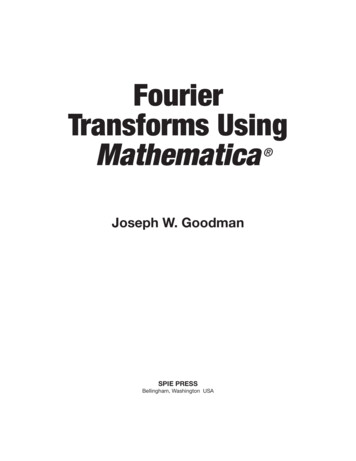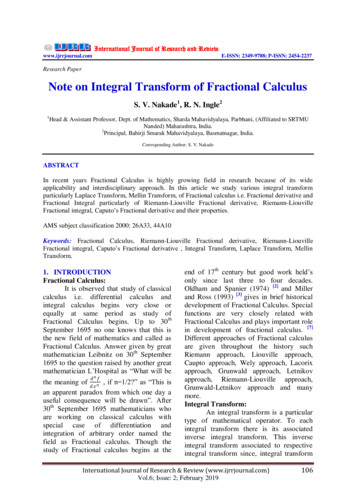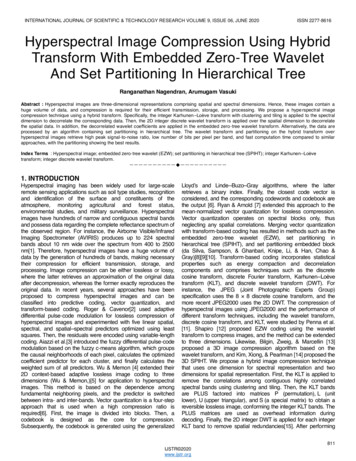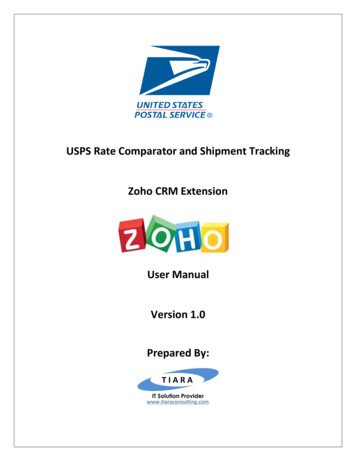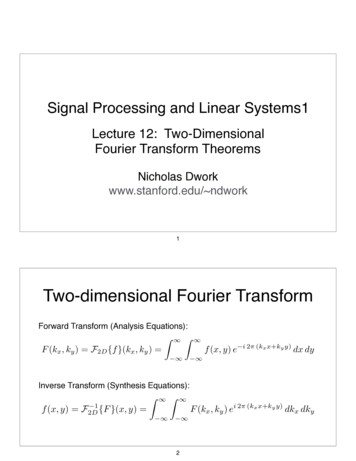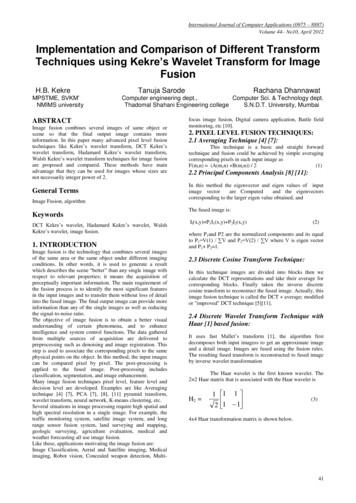Transcription
Energy storage: Tracking thetechnologies that willtransform the power sector
ContentsExecutive summary3Introduction4Across the value chainEnergy storage economics – A view through today’s lens57Storage costs7Storage benefits8Benefit/cost ratios9Bulk energy and ancillary services9Transmission & distribution, renewable integration11Consumers11Technological innovations – A look into what the future might bring13Disruptive technologies14Regulatory considerations – A need for reform16Implications - A call to action for stakeholders17Appendix A: Characteristics of energy storage technologies19Appendix B: Abstract and acronyms20Abstract20List of acronyms21
Executive summaryThe world’s population is expected to grow by two billionpeople by 2050 and global energy demand is expectedto roughly double during the same period.1 Concurrently,the power sector is on the brink of a major transformationas more stakeholders look into the possibility of movingaway from traditional fossil-energy-based centralizedpower systems towards the potential of renewable-energybased distributed generation. However, the penetrationof renewable technologies has been hampered by theircosts - which are improving - and their intermittency andvariability, which reduces availability and induces gridinstability. Therefore, the utility industry should considerovercoming these challenges if renewables are to accountfor more than just a negligible portion of the globalenergy portfolio.At present, the emerging consensus2 is that energystorage is the pivotal technology that will reshape theenergy sector by enabling widespread adoption and gridintegration of solar and wind renewables. In the sameway that transmission lines affect where electricity isconsumed, energy storage influences when it is consumed.Thus, commercial and residential consumers are providedthe flexibility to become power generators and to selectthe price point at which they will consume electricity,and utilities and the grid gain the agility to accommodateproducers and consumers with disparate temporalbehaviors. Regulators are beginning to recognize the valueof storage and are creating policies that further improvethe business case for adoption.Recent advancements in materials and manufacturing haveimproved the economics of storage. Traditional storagetechnologies such as pumped hydro and compressedair have limited applicability and are losing market shareto emerging battery technologies, many of which areleveraging experience in the transportation and consumerelectronics sectors to compete in the power sector. Inaddition to the various technologies that are gainingcommercial traction, there are numerous disruptivetechnologies under development that offer the potentialof step-change improvements in performance or cost.The multitude of current and emerging storage optionscan make it difficult to decide which technology toadopt and when. To assist decision makers, this paperoffers a preliminary feasibility assessment that evaluatesthe business case and benefit/cost ratio of storagetechnologies within certain customer classes.The impact of energy storage is far-reaching, as not onlydoes it address the issues that have limited renewableenergy’s penetration, it fundamentally alters thelongstanding relationship between utilities and theircustomers. The disruptive potential of storage is unlikeother energy technologies in that it pervasively extendsacross the value chain in a way that stakeholders willimpact and be impacted by its adoption. To remain acasual observer is to risk disruption, as even non-powercompanies (e.g., Tesla, Daimler) are entering the market.If the decision is to adopt, there is a need to translate thetechnical parameters of storage into financial implicationsto understand the bottom-line impact. If the decisionis to not adopt, there is still a need to respect theinterdependencies of the ecosystem and evaluate potentialimpacts to the business and operating model. Either way,the potential of storage requires that stakeholders developrobust strategies that decrease the risk and increasethe opportunity.1“2014 Energy and Climate Outlook,” MIT, 2014.2At a recent U.S. DOE “townhall” meeting (February 9, 2015), U.S. Secretary of Energy Ernest Moniz was asked to name a “Blue Sky” technologythat has the potential to revolutionize the energy sector. His response: “Distributed Energy Storage.” Similarly, a recent survey of electric utilitiesrevealed that energy storage is the top emerging technology that warrants investment. (2015 State of the Electricity Utility Survey Results)Energy storage: Tracking the technologies that will transform the power sector3
IntroductionEffective use of the world’s energy resources depends on having the flexibility to selectively provide energy at choice times,which is the fundamental concept behind energy storage technologies (Table 1) -- the conversion of energy from onestate to another (i.e., kinetic to potential or vice versa) so that it can be harnessed at a later date or used in an alternativemanner.3 The temporal flexibility offered by storage can help the power sector accommodate periods of supply/demandmismatch (from brief fluctuations to extended outages) and thereby improve the reliability of the grid, the quality ofits electricity, and the profitability of infrastructure investments.4 From a societal perspective, storage can address theemerging energy demand of rural areas, empower consumers to manage their energy consumption, and strengthen thevalue proposition of renewable energy installations.The potential benefits of energy storage have caught the attention of many stakeholders in the power sector, leading tosignificant growth. Installations associated with grid and ancillary services are projected to grow by roughly 40x over thenext 10 years (538.4 MW in 2014 to 20,800 MW in 20245) due to drivers such as renewable integration, energy demand,asset retirements, and technological innovation. Energy storage among end users (commercial and residential) is expectedto see even greater growth of 70x (172 MW in 2014 to 12,147 MW in 2024) due, in large part, to smart grid technology.6The range of storage technologies that will fuel these exponential growth rates spans the states of energy and theprinciples of physics.Table 1. Energy storage technologies7Kinetic energyThermaltechnologiesElectricaltechnologiesHot waterSupercapacitorsMolten saltSuperconductingmagnetic energyPotential altechnologiesChemicaltechnologiesPumped hydroLithium ionHydrogenCompressed airenergyLead acidSynthetic naturalgasPhase changematerialRedox flowSodium sulfur3“Energy cannot be created or destroyed but can be converted from one form to another.” The Law of Conservation of Energy.4“Electrical Energy Storage,” International Electrotechnical Commission White Paper, 2011.5“Energy Storage for the Grid & Ancillary Services,” Navigant, 2014.6“Community, Residential, and Commercial Energy Storage,” Navigant Research 2015.7“Electricity Storage Fact Book,” SBC Energy Institute, September 2013.4
Across the value chainThe stability of the power grid depends on various actors working in concert to maintain a balance between electricitysupply and demand. Traditionally, electricity assets are categorized based on their function; i.e., generation, transmission,or distribution. Storage systems differ in that they have the ability to balance supply and demand across the segmentsthat comprise the value chain. The new control points offered by storage systems enable operators to selectively respondto fluctuations in grid inputs and outputs. Such functionality is essential to realizing the vision of “smart cities” whereproducers and consumers are equally informed and equipped to respond to market dynamics in real time. However, manyelectrical grids were not originally designed to accommodate assets that can both generate and consume electricity. Theimplications of two-way power flow and the role of energy storage within a modern electricity ecosystem have beenstudied by many institutions. Potential applications and appropriate storage technologies within each segment of thevalue chain are illustrated in Figure 1.Figure 1. Energy storage across the power sector88“Energy Storage for the Electricity Grid: Benefits and Market Potential Assessment Guide: A Study for the DOE Energy Storage SystemsProgram,” SANDIA, December 2010.Energy storage: Tracking the technologies that will transform the power sector5
The disparities between electricity supply and demand can span timescales from milliseconds to months. A singletechnology, however, is incapable of operating across all potential timescales. Some technologies provide power quicklywhile others can deliver it over an extended period. While the need for storage spans the value chain and includesmultiple timescales, many grid-related applications cluster near the multi-hour discharge requirement. In addition, thevaluable applications also tend to require technologies that have multi-hour discharge durations, as shown in Figure 2.Figure 2. Energy storage applications and corresponding value for various discharge durations9 70 60 50 40 30Potential value of storageapplications for dischargeduration categories( Billion) 20ApplicationCategories 10 0Electric Energy Time-ShiftBulk EnergyElectric Supply CapacityAreaRegulationElectric SupplyReserve CapacityVoltage SupportAncillaryServicesLoad FollowingT&D Upgrade DeferralTransmissionSupportSubstation Onsite PowerTransmission Congestion ReliefTOU Energy Cost ManagementElectric Service ReliabilityConsumersDemand Charge ManagementElectric Service Power QualityRenewable Energy Time-shiftRenewablesIntegrationRenewables Capacity Firming10 hours9 hours8 hours7 hours6 hours5 hours4 hours3 hours2 hours1 hour1 minuteWind Integration1 secondTransmission& DistributionWhile the discharge duration of a technology is important and often governs whether it should be considered for aparticular application, there are numerous other chemical and physical characteristics that contribute to the final selectiondecision, such as: power rating, storage duration, cycling, self-discharge, energy density, power density, efficiency,response time (Appendix A). While these attributes may determine which storage technology may be preferred for acertain application, the fundamental factor that determines the feasibility of implementation is whether the benefitsoffered by a technology exceed its cost. A business case for storage adoption emerges only when the economics arefavorable enough to signify a potential return on investment.96Eyer, Jim; Garth Corey “Energy Storage for the Electricity Grid: Benefits and Market Potential Assessment Guide – A Study for the DOE EnergyStorage Systems Program,” Sandia National Laboratories, February 2010.
Energy storage economics –A view through today’s lensWhen evaluating the costs and benefits of energy storage for a single application, storage technologies are oftenprohibitively expensive compared to the alternatives. For example, when offsetting the intermittency of renewable energysuch as solar and wind, energy storage is often compared to combustion turbines, which can also flatten the powergeneration profile of renewable energy systems. Currently, PHS and CAES, both heavily capital-intensive, are the twotechnologies that are competitive with combustion turbines when the operational parameters associated with renewableintegration are considered.10 Other applications have similar competitive landscapes where storage technologies mustunseat incumbent technologies. To justify adoption, either the costs of energy storage technologies need reduced throughscale and technological innovation or the benefits need increased through stacking of services.Storage costsWhether an energy storage technology is a viable option for a particular application depends on its cost per unit ofpower or energy. Energy storage technologies typically excel at providing either power or energy, but not both. The costsassociated with the provision of power or energy are not necessarily positively correlated and, in fact, flywheels and CAESare two examples in which the cost of energy and power are negatively correlated.11 Figure 3 shows how the cost per unitof energy and power varies for each of the storage technologies in question.While Figure 3 represents current technology cost ranges, companies are actively engaging in R&D to reduce thecost of implementing storage systems. The pace at which advancements are made and costs reduced varies fromtechnology to technology.14 As one might expect, some of the more mature technologies have cost curves that do notdecline as significantly as others. For example, PHS is already mature and will experience small cost decreases based onmore efficient power station equipment and better construction techniques. Conversely, the cost of hydrogen storagesystems could decline rapidly as technological advancements in both production and electrification are achieved. Batterytechnologies are projected to experience similar cost reductions except in the case of NaS and a few of the Redox Flowbatteries, which may experience more rapid cost reductions.Figure 3. Theoretical capital cost of energy storage technologies12, 13EnergyPower5,54,4SMES3,32,21,102,24,4thousand /kw6,68,811thousand /kwhSupercapacitorPHSCAESFlywheelsNaSPb AcidLi-ionFlow Batteriesthousand /kwHydrogen543thousand /kwh21024681010“Electricity Energy Storage Technology Options – A White Paper Primer on Applications, Costs, and Benefits,” EPRI, December 2010.11“Electric Storage Factbook,” SBC Energy Institute, September 2013.12EPRI, December 2010; “Economic Analysis of Large-Scale Hydrogen Storage for Renewable Utility Applications,” SANDIA, Schoenung S.,August 2011.13Exchange rate as of 2nd April 2015, 1 1,1 This conversion rate is used throughout the paper.14The cost projections for the storage technologies used during the analysis are based on business cases conducted by various researchinstitutions, vendor inputs and expert interviews. Supercapacitors and SMES were approximated by a learning curve approach which states thatevery doubling of their units comes along with a certain cost reduction. (footnote: the reduction depends on the assumed learning rate andwas retrieved from IRENA, April 2014, “Electricity Storage – Technology Brief”).Energy storage: Tracking the technologies that will transform the power sector7
The siloed nature of the power sector presents a challengeto stacking services. That is, the current regulatoryenvironment does not create a means for each beneficiaryto compensate the technology. The Director of the EnergyStorage Association, Matt Roberts, suggests that “if thevalue that energy storage offers across the value chain issummed it exceeds the cost of the storage system,yet markets that allow a system owner to capture allthe value streams as compensation are still evolving.”18As a result, services are typically stacked within eachcustomer segment.Figure 4. Complementary energy storage applications17Bulk EnergyElectric Energy TimeshiftElectric Supply CapacityArea RegulationAncillary Electric Supply Reserve CapacityServicesVoltage Support1T&DTransmission Congestion ReliefT&D Upgrade DeferralTime-of-Use Energy CostManagementConsumersDemand Charge ManagementElectric Service ReliabilityElectric ServicePower QualityRenewables Energy TimeshiftRenewableIntegration Renewables Capacity FirmingWind Generation Grid Integration15“Decision Adopting Energy Storage Procurement Framework and Design Program” Order instituting Rulemaking Pursuant to Assembly Bill 2514to Consider the Adoption of Procurement targets for Viable and Cost-Effective Energy Storage Systems, Public Utilities Commission of the Stateof California, October 21, 2013.16“Energy Storage for the Electricity Grid: Benefits and Market Potential Assessment Guide,” Sandia, February 2012.17Eyer, Jim; Garth Corey “Energy Storage for the Electricity Grid: Benefits and Market Potential Assessment Guide – A Study for the DOE EnergyStorage Systems Program,” Sandia National Laboratories, February 2010.18Deloitte Interview with Matt Roberts, Director, Energy Storage Association.8Renewables Capacity FirmingWind Generation Grid IntegrationRenewables Energy TimeshiftElectric ServicePower QualityElectric Service ReliabilityDemand Charge ManagementTime-of-Use Energy CostManagementT&D Upgrade DeferralIncompatibleTransmission Congestion ReliefPoor SynergiesArea RegulationFair SynergiesElectric Supply CapacityGood SynergiesElectric Energy TimeshiftKeyExcellent SynergiesVoltage SupportEnergy Storage IntegrationElectric Supply Reserve CapacityBulkEnergyEnergy Storage ApplicationsStorage benefitsThe potential benefits offered by storage technologiesare monetized by organizations through increasedrevenues or reduced costs – both budgeted capital andoperating expenses. In addition, storage offers otherless quantifiable benefits, such as integrating renewableenergy and reducing greenhouse gas emissions.15 Whilethese “societal benefits”16 are important, it is difficult torationalize an investment based solely on externalities.Instead, implementation of energy storage technologiesdepends on the extent to which a technology can providea valuable service at a cost that is attractive compared tothe alternatives. Storage technologies differ from othersystems across the grid in that they can efficiently providemultiple services, thereby improving their economicviability. While the benefit/cost ratio for a single applicationmay not be favorable, an amalgamation of applicationsprovides multiple revenue streams for the sameinvestment. The effectiveness of this concept of “stackingservices” depends on the extent to which synergies existamong the applications being stacked (Figure 4).
Benefit/cost ratiosBecause the costs and benefits of energy storage are in continual flux, potential users are often unaware of whichtechnologies to consider during adoption decisions. In principle, technologies that should be on a customer’s radar arethose whose benefits exceed their costs. This is the initial step to determine the technologies that are feasible beforedown-selecting a technology that is optimal. The charts in Figures 5, 6, 719 assist in determining the feasibility of storagetechnologies by depicting when specific technologies are likely to warrant consideration within a certain customer class.In other words, the charts illustrate how the potential suite of storage solutions might evolve over the next 15 years forspecific customers. The charts provide a general indication of the year in which a storage technology becomes feasiblecompared to its peers and should attract the attention of customers. In addition, as a technology gravitates toward thecenter of the radar charts, it offers a greater benefit relative to its cost compared to the technologies at the periphery ofthe circle, but the ultimate selection will depend on whether a technology aligns to the adoption criteria, which variesamong customer classes.19Key information related to Figures 5,6,7: The curves represent average values, which is important because the ranges associated with both cost and benefit vary wildly depending oninnovation and market forces. The graphs indicate the year in which a technology with an average cost is suitable for an application with an average value. Companieswith low-cost technologies or markets with high value applications can shift the results. Regulatory factors such as government incentives in the form of rebates artificially change the benefit/cost ratio of a technology, therebyaffecting the results in the charts. The analysis considers the feasibility of technologies within certain customer classes, and in this way imposes borders between segments.The borders are consistent with the siloed nature of the global power sector, yet progressive regulatory changes are enabling storagetechnologies to deliver benefits across the value chain, which improves economics and impacts the charts. The scales of each customer class differ, which makes it difficult to make comparisons. For example, a “High” benefit/cost ratio is notequivalent across all classes. The scale within each class is relative to the technologies and applications associated with that class. Certain technologies are in developmental phases and are not immediately ready for commercialization. Such technologies appear on theradars during the timeframe in which commercial use is anticipated. Each graph considers the value and cost of energy- and power-based applications. The line captured within each radar chart represents thegreater of the opportunities presented by energy and power. Sources–– “Electricity Energy Storage Technology Options,” a white paper primer on Applications, Costs, and Benefits, Electric Power ResearchInstitute, December 2010.–– Eyer, Jim; Garth Corey “Energy Storage for the Electricity Grid: Benefits and Market Potential Assessment Guide – A Study for the DOEEnergy Storage Systems Program,” Sandia National Laboratories, February 2010.–– “Grid Energy Storage,” U.S. Department of Energy, December 2013.Energy storage: Tracking the technologies that will transform the power sector9
Bulk energy and ancillary servicesFigure 5. Energy storage radar charts for bulk energy and ancillary servicesBulk energyAncillary servicesBulk energyBulk energy storage involves shifting the energy production of current generators such that utilities can “buy low” and“sell high” within daily or seasonal markets. In addition, bulk energy storage systems can stave-off the need for thegeneration capacity offered by peaking plants.20 Currently, PHS and CAES are the feasible options for bulk energy storage;however, both depend on the availability of suitable topology or geology, which is often limited. In addition, financialchallenges emerge when rationalizing the large capital expenditures that are required to scale PHS and CAES systems tomaximize efficiency, especially in the case of CAES plants, which lack operational data to mitigate the risk of a 40 yearinvestment, even though they seem to be the most viable technology, as reflected in Figure 5.21 Conventional batteriessuch as NaS and Pb-Acid emerge as viable options that are likely better-suited for small- or medium-size applications dueto their scaling and lifecycle limitations. Similar technical constraints occur for Li-ion systems, which have much higherefficiencies and power densities, and are pushed by the automotive sector to become cost-effective, making themmuch more appealing than other conventional battery types. Flow batteries may emerge and even supplant existingtechnologies as they achieve commercial deployment. Since bulk storage requires relatively large amounts of energywith frequent discharges throughout the year, replacement and O&M costs are significant factors. Among the viabletechnologies, however, there are trade-offs between replacement and O&M costs because mechanical systems oftenrequire more maintenance during their lifetime, while electrochemical systems are more expensive to replace. Finally,hydrogen storage would be well-suited for bulk applications in the future, as the hydrogen could potentially be usedin conventional gas-fueled power plants. Currently, however, this opportunity is constrained by the tradeoff betweeninfrastructure modifications required to accommodate high blending percentages of hydrogen.2220In addition to storage and combustion turbines, capacity resources include demand response, energy efficiency, and distributed generation.21Interview with Dirk Uwe Sauer, Professor, ISEA RWTH Aachen, Electrochemical Conversion and Storage.22Hydrogen could be used in a current natural gas infrastructure given certain mixing (blending) percentages are met. If the thresholds are notrespected costly infrastructure modifications have to be implemented. Methanation could override this issue but has even higher total cost asadditional conversion steps are required.10
Ancillary servicesEnergy storage technologies are uniquely suited to provide ancillary services, which are currently being performed bygenerators that are not designed for this purpose. Moreover, the provision of ancillary services impairs the primaryfunction of traditional power generation assets by requiring that they operate at suboptimal levels in order to respondto changes in the grid. Energy storage, on the other hand, offers responsive technologies that can accommodate theneed for frequent but relatively short discharges. Currently, battery technologies such as Li-ion and Pb-acid are the mosteconomically viable storage options, with flywheels on the cusp of feasibility.23 (Flywheels provide an advantage in boththeir extended lifetime and minimal maintenance costs.) Supercapacitors and SMES are currently immature but offer thepotential for extremely high efficiencies and long lifetimes upon achieving commercialization.Transmission & distribution and renewable integrationFigure 6. Energy storage radar charts for transmission & distribution and renewable integrationTransmission & distributionRenewable integrationTransmission & distributionEnergy storage can improve the stability and performance of transmission assets as well as defer the need for additionalinfrastructure by alleviating traffic congestion along transmission lines during peak times. Conventional batterytechnologies are currently being used within the T&D space with researchers at Sandia National Laboratories estimatingthat “100,000 battery storage systems (are installed) at utility substations in the U.S.”24 In addition, above-ground CAESappears to be a viable option for T&D applications in instances where space is less of an issue. Within the T&D segmentthere are also applications that require sub-second responses (e.g., transmission support) that will make SMES andsupercapacitors desirable technologies. Going forward, flow batteries will present an intriguing option based on thepotential benefit/cost ratio once they achieve commercial maturity.Renewable integrationStorage technologies are essential for renewable energy systems to realize their full potential. Renewable power isoften produced at inopportune times, resulting in an undesirable price or possible curtailment. Storage can improve theeconomics of renewable systems, yet the appropriate storage technology depends on the renewable installation, as PVand wind differ both in technology and size. CAES and PHS are initial energy storage options because they are apt toaccommodate the daily and seasonal intermittency issues of renewables. However, PHS and CAES have siting constraints,23Current sample projects, Pb Acid: Kaua’i Island Utility Cooperative, designed to mitigate the variability of the island grid, monitoring the powersupply and correcting for frequency and voltage deviations, Li-ion: United Kingdom, England, Bedfordshire, Leighton Buzzard, Smarter NetworkStorage, services to distribution network operators and transmission system operators.24“Energy Storage for the Electricity Grid: Benefits and Market Potential Assessment Guide,” Sandia, February 2012.Energy storage: Tracking the technologies that will transform the power sector11
which can limit the technology’s application depending on the location. CAES would best fit windy, coastal areas withunderground caverns, such as Northern Germany, which would assist with the integration of both on- and offshore windenergy.25 As batteries mature, they will be leading the energy storage market in small- to mid-sized installations. Flowbatteries offer interesting options in cases where traditional batteries may have lifecycle issues. Finally, chemical storagetechnologies such as hydrogen could be an appropriate choice as they offer additional flexibility in how the energy isultimately used (electricity, heat, or transportation).ConsumersFigure 7. Energy storage radar charts for consumersCommercial & industrial usersCommercial, industrial, and residential consumersConsumers of electricity stand to benefit from energystorage technologies, as the smart grid enables usersto selectively adjust their energy consumption patterns.Specific storage technologies will vary depending onwhether the customer class is residential or commercial.As one might expect, residential applications are smallerin scale, and safety and simplicity are critical. Li-ionand Pb-acid are viable options for residential energyapplications in the near term. Redox storage technologiesoffer intriguing potential once commercialized. Sodiumsulfur and Advanced Pb-acid batteries are currently viableoptions for commercial and industrial consumers, as areflywheels for power-based applications. Hydrogen and flowbatteries offer advantageous benefit/cost ratios with highquality energy densities and storage capabilities as theymature to commercialization. Hydrogen storage, however,requires an additional electrification system if blendingpercentages are not met (i.e., special hydrogen turbines2512“Druckluftspeicher-Kraftwerke,” BINE Informationsdienst, 2007.Residential usersor fuel cells, which increases both capex and maintenancecosts). Both residential and commercial consumers will lookto flywheels and certain types of batteries capable of shortdischarge durations to maintain their electric service powerquality.To maintain electric power quality, residential andcommercial consumers will look to flywheels, as well ascertain batteries, that are capable of rapid discharge.Such batteries can serve a dual purpose by satisfying bothenergy and power applications.The results presented within the radar charts and theactions taken within each customer class will be affectedby the extent to which innovations alter a technology’scost curv
4 "Electrical Energy Storage," International Electrotechnical Commission White Paper, 2011. 5 "Energy Storage for the Grid & Ancillary Services," Navigant, 2014. 6 "Community, Residential, and Commercial Energy Storage," Navigant Research 2015. 7 "Electricity Storage Fact Book," SBC Energy Institute, September 2013.

